Five Places Where You Can Collect Fossils in the D.C. Area
You don’t have to venture far to make awesome finds
/https://tf-cmsv2-smithsonianmag-media.s3.amazonaws.com/filer/20/ab/20ab08fe-f08f-4a27-a807-6a1e3252ee26/boy_walking_on_beach_at_westmoreland_state_park.jpg)
About 20 million years ago, the land that’s now Virginia, Maryland and the nation’s capital Washington, D.C. was underwater. Where monuments now stand, giant megalodon shark hunted down prehistoric whales and dolphins and fish darted through coral. The marks these creatures left on the world haven’t washed away, as folks stumble on fossil evidence of their ancient lives all the time.
The Smithsonian’s National Museum of Natural History boasts fossils from all around the world, and yet plenty come from the area surrounding the museum itself. There’s a Miocene era baleen whale skull on display that was found in the Calvert Cliffs in Maryland, for example. A giant Megalodon replica hangs from the atrium in the cafe; a nearby plaque explains that you can still find “Meg” teeth on the shores of the Chesapeake Bay.
For amateur fossil hunters dreaming of coming across a megalodon tooth on the beach, we’ve curated a list of fossil hot spots just a hop, skip and jump from the Natural History Museum.
Calvert Cliffs - Lusby, Maryland
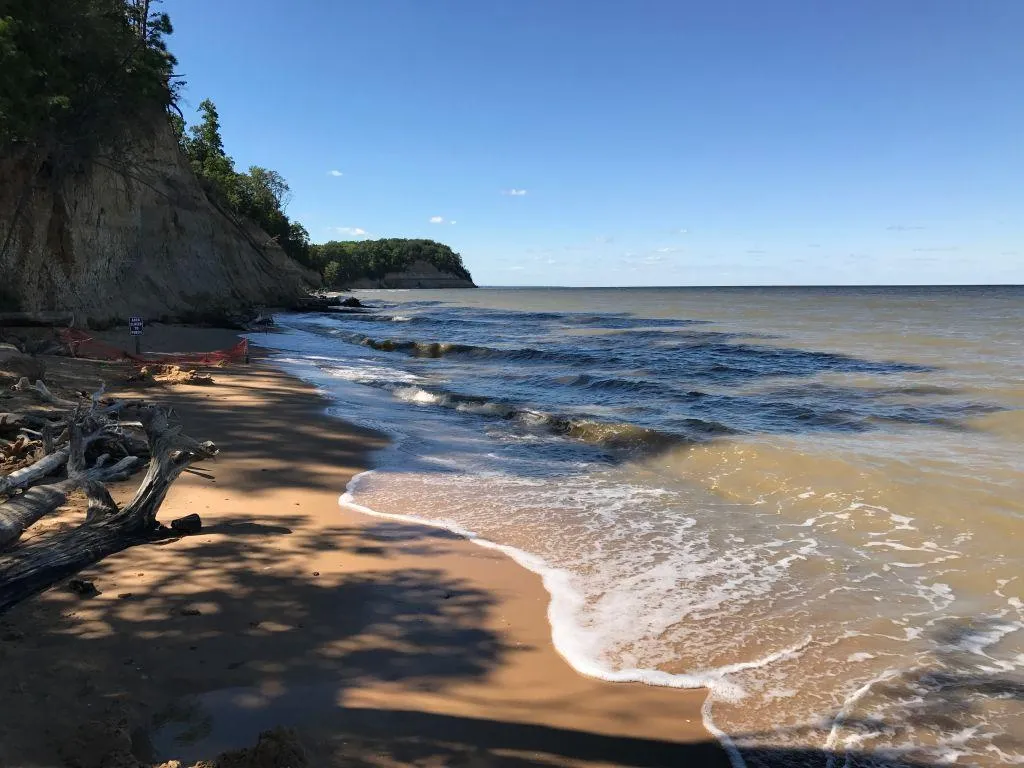
Perhaps the most well-known fossil site on the east coast, the Calvert Cliffs cover about 24 miles of shoreline in Maryland. More than 600 species of fossils, including prehistoric oyster shells, mollusks and scallops as well as shark teeth, have been found on the shores. You might even find a megalodon tooth—most likely, however, you’ll find smaller teeth of other kinds of ancient sharks. Most finds date back to the Miocene era, or around 15 million years ago.
You might be wondering why it is so easy to find shark teeth millions of years old on the beach. According to Smithsonian marine paleobiologist David Bohaska, sharks lose their teeth and regrow new ones constantly. In its lifetime, he explains, a single shark can have thousands and thousands of teeth.
One location where you can access the cliffs is at Calvert Cliffs State Park in Lusby, Maryland. Just a 1.8-mile walk from the parking lot, you can scour the open beach area with a small shovel and sieve—these you’ll need to bring yourself—for remnants of prehistoric sea life. (Don’t bring a hammer or bang on rocks as this will only damage the fossil, Bohaska advises.) The cliffs are layered at a slant, so you’ll find fossils from different geologic time periods depending on where you are.
“The layers at the top are the more recent chapters and the stuff at the bottom is older,” Bohaska explains. He warns that it is illegal to climb on the cliffs or search beneath them in this area, so pay attention to signage.

“You’re out in the wild, be aware,” says Bohaska. “If you look at the cliff and it has a crack, or if there’s a tree overhanging, that’s not a place you want to stand.”
You can find lots of in-depth information about where to look for fossils and how to determine what you found on the Maryland Geological Survey website. You can also download Smithsonian Scholarly Press’ The Geology and Vertebrate Paleontology of Calvert Cliffs, Maryland, USA online.
Be sure to plan ahead for filled-to-capacity closures on busy holiday weekends like Labor Day. And pack your mask: The Maryland Park Service requires face coverings in public buildings and outdoor public spaces wherever social distancing is not possible.
Stratford Hall - Stratford, Virginia
In 1717, Virginia colonist and politician Thomas Lee purchased Stratford Hall, a 1,200-acre property in Stratford, Virginia. About 17 million years earlier, during the Miocene era, however, the Stratford Hall estate’s towering 150-foot-high cliffs were actually part of the seafloor, according to its website.
In 2013, amateur paleontologist Jon Bachman—who serves as Stratford Hall’s educational events coordinator—found a 15-million-year-old whale skull on the shores of the Potomac River at the four-generation Lee family home, where Robert E. Lee was born in 1807. The six-foot-long, 1,000-pound fossil was unearthed when the banks of the river eroded that summer. The skull was “the biggest” found near the cliffs, but there’s plenty more where that came from, including “shark-toothed porpoises, salt-water crocodiles, sea cows, gopher turtles [and] rays,” according to Stratford Hall’s website.
The cliffs still turn loose small fossils as they erode. As sediment accumulated for millions of years, the ocean underwent a series of marine transgressions, meaning that over a long period of time, the shoreline receded and advanced several times. Each time that movement happened a new layer of sediment was dumped, and those layers can be seen as one looks up at the cliffs.
“The back and forth of the ocean created the right environment to preserve the remains of countless animals,” Bachman explains. “Now, as the river current scours the cliffs, these fossils are exposed and slowly emerge out of the cliffs. That’s what people want to find.”

Today, the waterline at the Stratford cliffs is about 16 million years old, Bachman says.
Due to irresponsible fossil hunting practices, however, visitors must purchase a grounds pass ($8 for adults and $5 for kids) to access a small, well-marked, 100-yard-long collecting area on the beach. The Hall still offers guided collecting tours led by one of their Paleo Patrol volunteers, explains Alex Withers, an events coordinator at Stratford Hall. Tours are typically about four hours long. Withers notes there is limited weekend tour availability left in the 2020 season, but they are taking reservations for 2021. (You can read up about their COVID-19 guidelines on their website.)
Bachman, who used to be a fourth grade teacher in Virginia’s Prince William County, says making fossil collecting a lifelong hobby is a worthwhile adventure. “It takes patience, this stuff isn’t littering the ground,” he says. “It’s humbling and fascinating hobby.”
Start with reviewing the principles of geology, Bachman suggests. Then move on to studying the geology in your area, which will tell you what rock formation and landscape features are nearby—and therefore, what fossils might be found there. State geologic societies have useful information on their websites.
“It’s just a delight and you don’t have to get a degree in it to enjoy it,” he adds. “You can educate yourself in stages. It’s about familiarizing yourself with the landscape around us.”
Westmoreland State Park Fossil Beach - Montross, Virginia
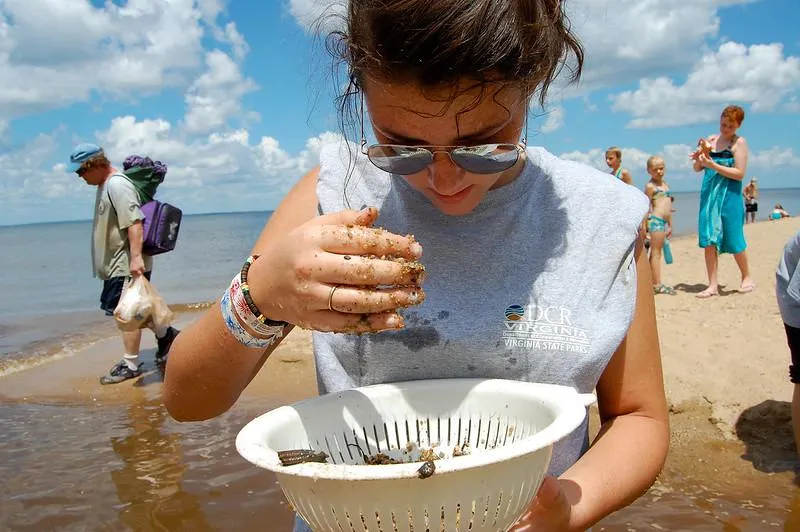
About 70 miles south of the Natural History Museum, Westmoreland State Park’s Fossil Beach is another hotbed for prehistoric shark teeth, but what’s really eye-catching about the location is the stratigraphy—or rocky layers—of the cliffs. Gazing up at the cliffs’ stripes is like looking 25 million years back in time; each layer represents millions of years of geologic history. Fossil Beach neighbors Stratford Hall, so the geology in both areas is similar.
“The river current erodes the sediment and fossilized material washes up on the beach,” explains Bachman, who lives nearby and collects fossils at this location. Bachman’s wife, Dianne, recently found the lower part of a leg bone, which they later found out may belong to a Miocene pseudo-toothed pelican, Pelagornis miocaenus, after having their colleague Robert Weems, a paleontologist with the U.S. Geological Survey, take a look. The bone is about six inches long and hollow, much like bird bones are today.
“People probably stepped over it a million times,” says Bachman.
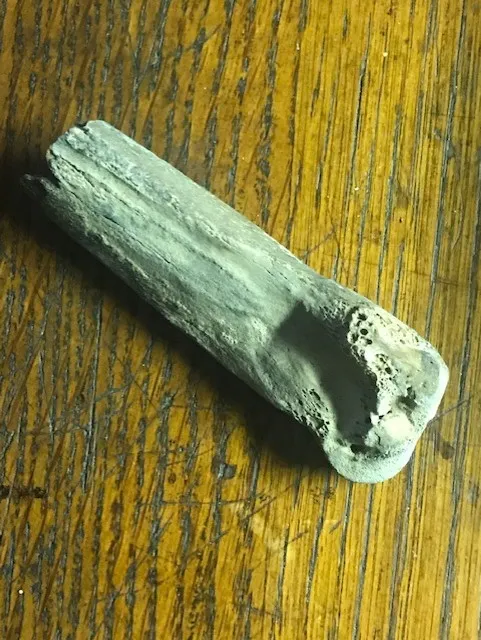
The area was once home to the unique prehistoric whale species, Eobalaenoptera harrisoni. A model of the 14 million-year-old baleen whale hangs in the Caroline County visitor’s center just a short drive from Fossil Beach. When the original fossil was excavated in the 1990s, researchers recovered half of the full skeleton, making it one of the most complete and largest prehistoric whale skeletons in the U.S. The skeleton is housed in the Virginia Museum of Natural History in Martinsville.
During the pandemic, “face coverings are required in all park facilities and where social distancing is not possible,” according to the park’s website. Virginia State Parks also recommends bringing your own soap and hand sanitizer. Of course, respect social distancing and keep a six-foot space between yourself and others. Step aside to let others pass on trails.
Purse State Park - Nanjemoy, Maryland
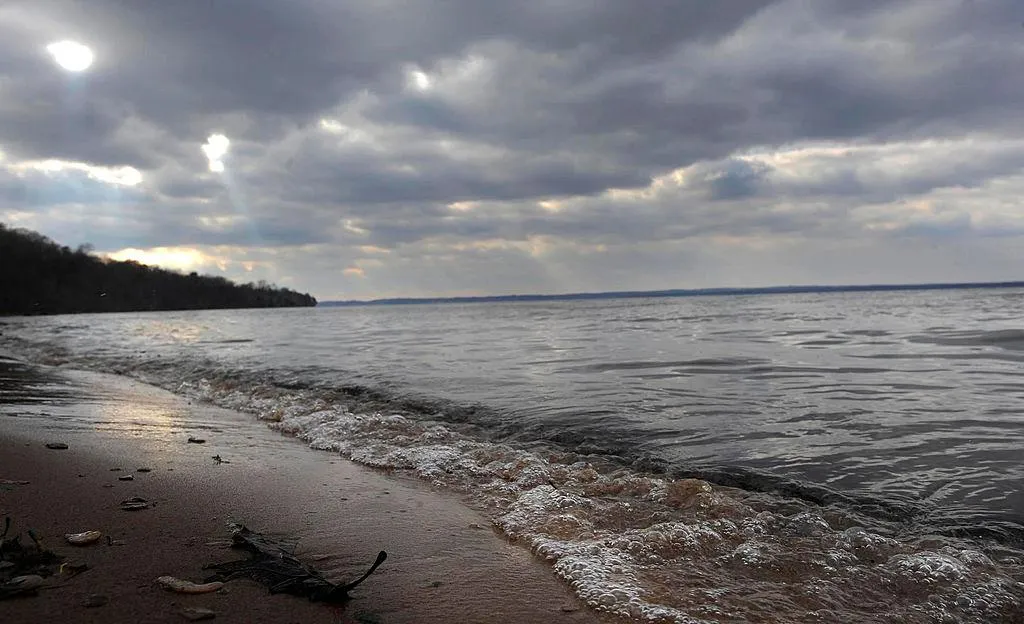
Just over an hour’s drive south of D.C., Purse State Park is located on a stretch of the banks of the Potomac River called Wades Bay. Paleontologist Michelle Pinsdorf of Smithsonian’s National Museum of Natural History says most of the fossils you’ll find at this site are from the late Paleocene—specifically the Aquia Formation rock layer, which is 55 to 59 million years old.
“During this time period, many types of animals were evolving and diversifying to adapt to the extinction event at the end of the Cretaceous time period,” Pinsdorf writes in an email to Smithsonian magazine. “Because the deposit is marine in origin, the teeth of a wide variety of shark and bony fish species can be found in this formation.”
Alongside shark teeth, you may find an occasional prehistoric crocodile tooth, which by comparison sort of look like “an ice cream cone with an almost silky texture,” says Bohaska.
You’ll also spot plenty of fossilized shells. Pinsdorf says prehistoric oyster shells are among her favorite finds at Purse State Park. “Although they are heavily eroded and don't have much of the shell pattern or shape left, they are a beautiful purple color and have an interesting luster and smooth texture,” she says.
The ideal time to search is during low tide when there is enough shoreline to scour. “But if you go in the days after a storm or rough waters, you're more likely to find fossils that have recently eroded out of the bedrock, and are in better condition as a result,” explains Pinsdorf.
The trails are unmarked so it’s important to carry a compass and map, according to Maryland’s tourism department. Pinsdorf suggests taking a quarter-mile trail westward, across the road from the Park's parking area on Route 224 (Riverside Road), to a narrow stretch of beach along Wade’s Bay.
“Bringing a colander or mesh screen is recommended to aid in sifting the gravel, in which small but numerous shark teeth and can be found,” she says. “Larger, weathered oyster shell fragments are present at this site also.”
During the coronavirus pandemic, face coverings are required in park buildings and outdoor areas where social distancing is not possible. Some parks have introduced additional cleaning procedures for restrooms or closed public restrooms. Others may be offering portable bathrooms instead, according to Maryland’s Department of Natural Resources.
Dinosaur Park - Laurel, Maryland
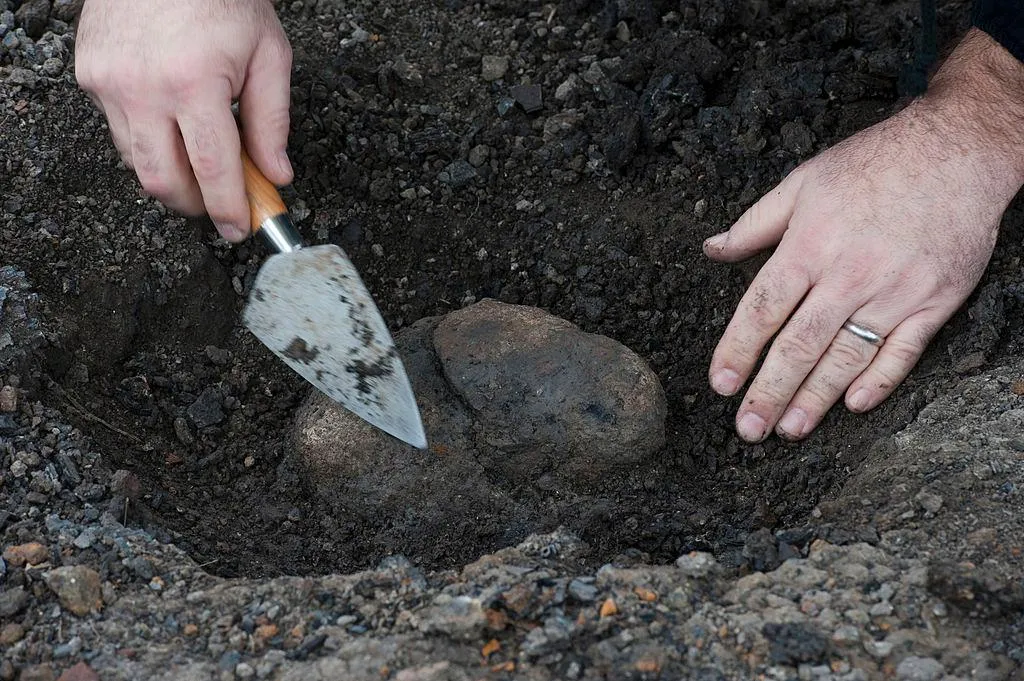
Originally a prime site for iron mining, African American miners in 1858 were the first to discover dinosaur fossils at this site. Geologist Philip Thomas Tyson brought the fossilized bones from the mines to a scientific conference in 1859, where they were officially identified as dinosaur remains.
“It’s a place where people have been working for a few hundred years,” explains paleontologist Matt Carrano of Smithsonian’s National Museum of Natural History. If the area where Dinosaur Park now stands hadn’t been mined at all, it would look like a normal Maryland hillside covered in vegetation. “It’s only a good spot for fossil collecting because it was mined for so long,” he says.” You’re looking at bedrock where there should be soil.”
Today, Dinosaur Park features fossilized dino bones, including some from Maryland’s state dinosaur Astrodon johnstoni, and floral remnants from the early Cretaceous period about 115 million years ago. At the time, the region would have resembled something like a swampy bayou with muddy streams. According to Carrano, the sediment was a very fine, almost “pottery-quality,” clay-like material.
“You’re walking on a clay layer that was deposited 110 million years ago,” Carrano says. Now, when it rains, the clay absorbs the water and then dries out again, revealing fossil fragments in that process. The most common finds are plant material, like wood and pine cones.
“Every now and then the conditions are just right and you get a situation when the environment is saving things instead of recycling them,” Carrano explains.
Due to COVID-19, all public programs and fossil collecting at Dinosaur Park are currently on hold, but the park area is open from sunrise to sunset. The unrestricted area features a Cretaceous-era garden and a climbable dinosaur “skeleton.” Signs describe the kinds of dinosaurs that once roamed the area, what Maryland’s prehistoric environment looked like and the African American history in the area, according to the park’s website.
Dinosaur Park usually serves as an outdoor laboratory, where the public can work alongside paleontologists to help uncover the past on the first and third Saturdays of the month or by appointment. Hundreds of fossils discovered by visitors have been collected and cataloged to date, enhancing our knowledge about the ancient ecosystem that once existed here.
“There’s a steady stream of new discoveries,” Carrano says. “We’re in this phase when the variety is much greater than we knew, just because we didn’t have much collected from the area. Many times, you’ll know you have something new, but you don’t have enough of it to give it a new name.”
Planning Your Next Trip?
Explore great travel deals
Smithsonian magazine participates in affiliate link advertising programs. If you purchase an item through these links, we receive a commission.
/https://tf-cmsv2-smithsonianmag-media.s3.amazonaws.com/accounts/headshot/rachael.png)



/https://tf-cmsv2-smithsonianmag-media.s3.amazonaws.com/accounts/headshot/rachael.png)